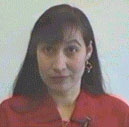Task:
Alright, alright. You are probably saying: "Sure, those are LCTLs
(well, if you did the terminology page and quiz you might say that).
I could probably understand it if she spoke something like Spanish."
Well, let's try Spanish, then. Everybody speaks some Spanish,
after all, and there are lots of cognates.

loading video...
|
Class: Psychology
Instructor: Patricia Martínez de la Vega Mansilla |
Now, answer the question below in the space provided:
5. What is this Psychology lecture about? List any ideas
or words that are familiar to you. Write your response in
the box below.
Perhaps this time the visual representation will help.
Take a look at the corresponding
text and see what you can glean from it.
6. Write down any ideas you comprehend from this lecture or,
at the very least, as many cognates as you can find. Write
your response in the box below.
Task:
Well, that was a little easier, wasn't it? But it still wasn't
like understanding everything the teacher was saying, right? Let's
try a completely different content area: Physical Education. Surely
THAT will be easier.

loading video...
|
Class: Physical Education
Instructor: Wolfgang Krause |
7. What is this instructor trying to teach you? What
does he want you to do?

loading video...
|
Class: Physical Education, Take Two
Instructor: Wolfgang Krause |
8. Now do you understand what to do? Why?
Every culture has its myths, legends, and stories that are commonly
known to everyone. In the United States, for example, everyone "knows"
that:
George Washington chopped down a cherry tree and then admitted the deed
to his father, setting an example not to lie.
Abe Lincoln walked several miles to return a few cents to a customer, thus
exemplifying his honesty.
Whether or not these stories are true, people can recite them by heart,
make reference (veiled or otherwise) to them and expect to be understood
completely. The historical Chinese text above is an example of this
type of cultural knowledge; everyone in China knows about the origin of
the Duanwu
Festival and will recite the same story. But you probably did
not understand much, if anything, from the recitation or the reading, did
you? This is due to several factors:
unfamiliar vocabulary and language structure
unfamiliar sounds of the language
unfamiliar cultural knowledge
unfamiliar writing system
ESL/LEP students deal with these problems on a daily basis when they are
in content classes. While not all ESL/LEP students are dealing with
a new writing system, they are confronted with the other factors that loom
large in their understanding or lack thereof.
Reflection:
In this simulation,
you are in these classes for credit and a grade, just like your ESL/LEP
students. Keeping this in mind, respond to the following questions:
9.
How did you feel when you could not understand the spoken lecture, the
written text, or the instructions without demonstration? Write
your response in the box below.
10.
What should you keep in mind when preparing lessons in your content area
for all students, including those who are ESL/LEP? Write
your response in the box below.